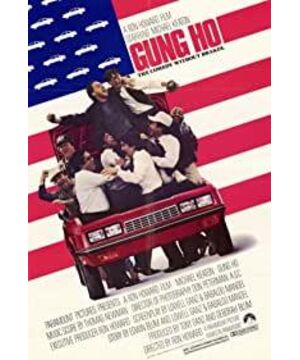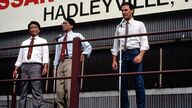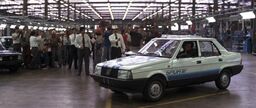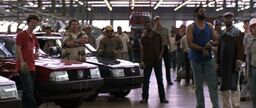If you create a user account, you can add your own review of this DVD Released 9-Sep-2003 This review is sponsored by BUY IT Details At A Glance General Extras Category Comedy None Rating Year Of Production 1986 Running Time 107:28 RSDL / Flipper No/No Cast & Crew Start Up Menu Region Coding 4 Directed By Ron Howard Studio Distributor Paramount Home Entertainment Starring Michael Keaton Gedde Watanabe George Wendt Mimi Rogers John Turturro Soh Yamamura Sab Shimono Case ? RPI $24.95 Music Thomas Newman Video Audio Pan & Scan/ Full Frame None English Dolby Digital 5.1 (448Kb/s) Widescreen Aspect Ratio 2.05:1 16x9 Enhancement Video Format 576i (PAL) Original Aspect Ratio 2.35:1 Miscellaneous Jacket Pictures No Subtitles None Smoking Yes Annoying Product Placement No Action In or After Credits No NOTE:The Profanity Filter is ON. Turn it off here. Plot Synopsis This film is called Gung Ho in the US, but I guess they thought that title wouldn't be understood elsewhere, so we get it as Working Class Man (yes, the Jimmy Barnes song does appear, under the closing credits). I think that I first saw this film on video, shortly after it had played in the cinemas. The film is set in Hadleyville, which is basically Small Town, USA. The town is dying , because this is the late 1980s, when the USA is going through the most painful part of its transition from industrial to post-industrial society. Hadleyville used to have two large factories, one turning out underwear and one making cars. The underwear factory closed , leaving the town dependent on the car plant as the major employer in the town. Now the car plant has been shut down for months,and the town is fading fast. People are leaving, shops are closing. In a last-ditch effort, they send the factory foreman, Hunt Stevenson (Michael Keaton) to Japan to try and interest Assan Motors in taking over the plant. After a mildly offensive (in today's terms) trip through Japan, which includes him barging into places where he doesn't belong, Hunt returns home, convinced that he has failed. But he hasn't. Assan Motors sends a jet-full of executives, led by Kazihiro-san (Gedde Watanabe, who puts in an excellent performance) to take over the plant. This film is about culture shock, and it runs both ways. The jingoistic Americans see the Japanese as uptight, unreasonable, dictatorial, and strange . The Japanese see the Americans as lazy, egotistical, not team-players, and strange. The process is not helped by Hunt's appointment as employee liaison. Hunt lies to both sides, and does next to nothing in terms of helping them to understand one another — not because he is intending to deceive them, but because he is cowardly, afraid to tell them things they don' t want to hear. As matters deteriorate, he comes up with the bright idea of setting a challenge: if the plant can turn out 15,000 cars in one month, the Japanese will raise wages and guarantee full employment (if you're young, you 've probably never heard the term "full employment". Now things get interesting. Unfortunately, Hunt lets the employees think that there's a lesser target for which they'll receive a smaller raise. Add to this a suggestion of nepotism, in that Kazihiro has a second-in-command called Saito (Sab Shimone), who is Kazihiro's boss's nephew.Saito is reporting back to Mr Sakamoto (Soh Yamamura), who is reporting back to his uncle on how things are going. This is Kazihiro's last chance: he failed in his last job, and was sent through a retraining programme for shamed executives. It's amusing to see the portrayed American attitude to a policy of zero defects — something that is now common. I found this film rather funny back in the late 1980s. Now I find it quite dated, and occasionally a bit offensive, but I think that is rampant political correctness at work. If you watch carefully, this film gives as much time to making points about small-town American mentality as to pointing out oddities in Japanese culture. It's given to George Wendt to display the worst intolerance, and it is clear that his behaviour is not approved of by the others. All in all,this is a dated comedy, but still amusing, providing you view it in the context of the culture that produced it. Don't wish to see plot synopses in the future? Change your configuration. Transfer Quality Video This transfer is presented at an aspect ratio of about 2.00:1, 16x9 enhanced. The original theatrical aspect ratio was 2.35:1, shot in Panavision. This is better than pan-and-scan 1.33:1, better than 1.78:1, but still not the original aspect ratio . Still, there are no obvious mis-framings, so it's not too bad. The image is uniformly quite soft. Shadow detail is dreadful — darker shades drop off into black far too quickly. Film grain does not appear to be a big problem, but it could be a contributor to the softness of the transfer. There is no low-level noise. Colour isn't too bad,but comes across as dull and lifeless. There are no colour-related artefacts, but there are some scenes that feature over-hot whites, particularly at the start of the film. There are plenty of small film artefacts: spots, flecks, and chips ; but they are generally untroubling. There is only a little aliasing and just hints of moiré, but there are no MPEG artefacts. There are no subtitle tracks. There are some subtitles burned into the image for some of the Japanese dialogue — they are easy to read, and seem well-timed to the dialogue, but without the ability to speak Japanese I cannot assess their accuracy. The disc is single-sided and single layered. That means there is no layer change.Video Ratings Summary Sharpness Shadow Detail Colour Grain/Pixelization Film-To-Video Artefacts Film Artefacts Overall Audio The soundtrack is only provided in English. Strangely, it is Dolby Digital 5.1 at 448 kbps — strangely, because there's no use of the subwoofer (except in the 4th of July fireworks), no significant use of the surrounds, and next to no stereo image. Heck, a Dolby Digital 1.0 soundtrack would have been adequate to convey what we get here. There's a little distortion in one or two places, but it's quite minor. The dialogue is clear and easy to understand. There are no obvious audio sync problems. Thomas Newman has provided an adequate score, although more than a little of it sounds somewhat clichéd.Audio Ratings Summary Dialogue Audio Sync Clicks/Pops/Dropouts Surround Channel Use Subwoofer Overall Extras There are no extras. Not a single one. Menu The menu is static and silent, and features only Play and Scene Selection. Despite the movie being 16x9 enhanced, this menu is not, so it looks too wide on a 16x9 display. R4 vs R1 NOTE: To view non-R4 releases, your equipment needs to be multi-zone compatible and usually also NTSC compatible. The Region 1 version of this movie ( released over a year ago) is reported as being 1.78:1 aspect ratio on one site (which is worse than this disc), and 2.10:1 on another (which might be what we have here) — I suspect that the latter is more accurate. The R1 disc has English and French soundtracks, and English subtitles — that's more than the R4 — but it doesn'tt make enough difference to make me give the win to the R1. Summary A movie that's pretty much past its use-by date, but that still offers a few laughs. The transfer is sub-standard, though. The video quality is poor. The audio quality is adequate. The extras are utterly absent. Ratings (out of 5) Video Audio Extras Plot Overall ©
View more about Gung Ho reviews











